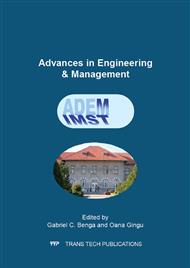[1]
Jun Wang, JiXiong, Hongyuan Fan, Hong-Shan Yang, Hao-Huai Liu, Bao-LuoShen, Effects of high temperature and cryogenic treatment on the microstructure and abrasion resistance of a high chromium cast iron. J. Mater. Process. Technol., (2009).
DOI: 10.1016/j.jmatprotec.2008.07.035
Google Scholar
[2]
D. Senthilkumar, I. Rajendran, M. Pellizzari, Juha Siiriainen, Influence of shallow and deep cryogenic treatment on the residual state of stress of 4140 steel. J. Mater. Process. Technol., (2011) Vol. 211, p.396÷401.
DOI: 10.1016/j.jmatprotec.2010.10.018
Google Scholar
[3]
D. Das, K. K. Ray, A. K. Dutta, Influence of Temperature of Sub-Zero Treatments on the Wear Behaviour of Die Steel. Wear, Issue 9-10, (2009) Vol. 267, p.1361÷1370.
DOI: 10.1016/j.wear.2008.11.029
Google Scholar
[4]
Barron R. F, Cryogenic treatment of metals to improve wear resistance, Cryogenics, 22, (1982) p.409–414.
DOI: 10.1016/0011-2275(82)90085-6
Google Scholar
[5]
P. I. Patil, R. G. Tated. Comparison of effects of cryogenic treatment on different types of steels: A review. http: /research. ijcaonline. org/iccia/number9/iccia1068. pdf - 21 pages.
Google Scholar
[6]
Mohan Lal D., Renganarayanan S., Kalanidhi A., Cryogenic treatment to augment wear resistance of tool and die steels, Cryogenics, 41, (2001) p.149–155.
DOI: 10.1016/s0011-2275(01)00065-0
Google Scholar
[7]
Seah KHW, Rahman M, Yong KH, Performance evaluation of cryogenically treated tungsten carbide cutting tool inserts. Proc IME B J Eng. Manufact 217, (2003) p.29÷43.
DOI: 10.1243/095440503762502260
Google Scholar
[8]
Hemant B. Patil, Prashant B. Chavan, Shoeb H. Kazi, Effects of cryogenic on tool steels-a review, IJMPERD, Volume-1, Issue 1, (2013) pp.31-36.
Google Scholar
[9]
Wayne Reitz, John Pendray, Cryoprocessing of materials: a review of current status. J. Mater. Manuf. Process, vol. 16 (6), (2001) pp.829-840.
DOI: 10.1081/amp-100108702
Google Scholar
[10]
Alexandru, Ailincai G, Baciu C., Influence ofcryogenic treatments on life of alloyed high speedsteels. Mem. Etud. Sci. Rev. Metall., 4, (1990) p.203–6.
Google Scholar
[11]
Nirmal S. Kalsi, RakeshSehgal, and Vishal S. Sharma, Cryogenic Treatment of Tool Materials: A Review Mater. Manuf. Process, 25, (2010) p.1077–1100.
Google Scholar
[12]
S. Dubovan, M. Demian, A.C. Calopereanu, L. Dubovan, Effects of sub-zero treatment aapplied to sintered steels. Newsletter Scientifically, UPB, Series B, Vol. 76, Iss 1, (2014)p.187÷208.
Google Scholar


